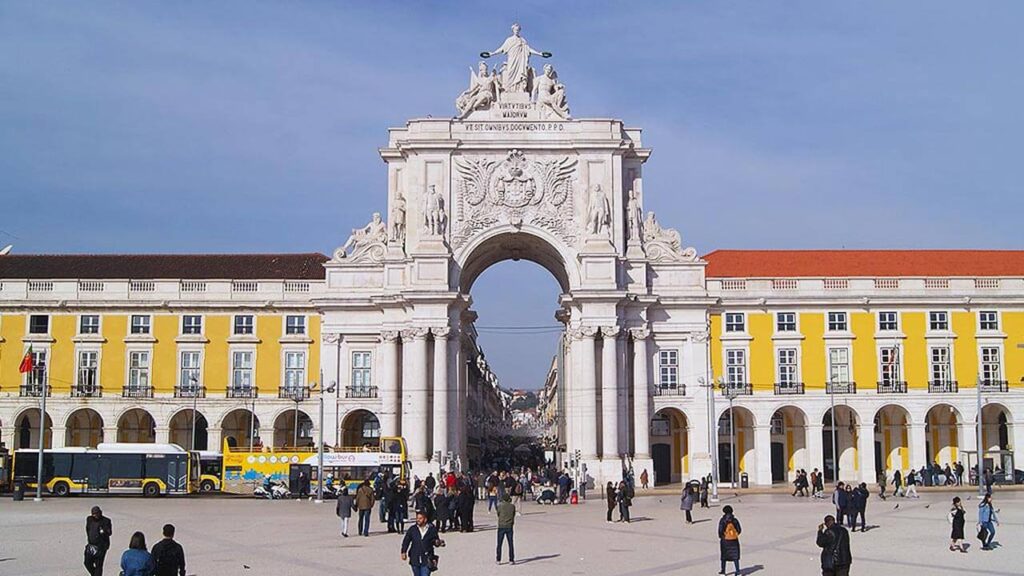Original article published on 11 March 2020
Situated in one of the most beautiful squares of the world, the Triumphal Arch of Praça do Comércio, most commonly known as Rua Augusta Arch, is the monumental gate that connects Lisbon to Tagus river.
The construction process of this Triumphal Arch, the emblematic finishing element of the buildings that constitute the former Terreiro do Paço, was long and certainly not controversy-free.
Supported by grandiose columns it is topped by a set of sculptures that carries a lot of meaning.
Today it is one of the tourist attractions of the city and a must-visit place for the Portuguese as well as for foreigners, as it provides a stunning 360-degree view over the river and the Pombaline Downtown.
By purchasing your tickets here you are supporting the getLISBON project.
The New Praça do Comércio
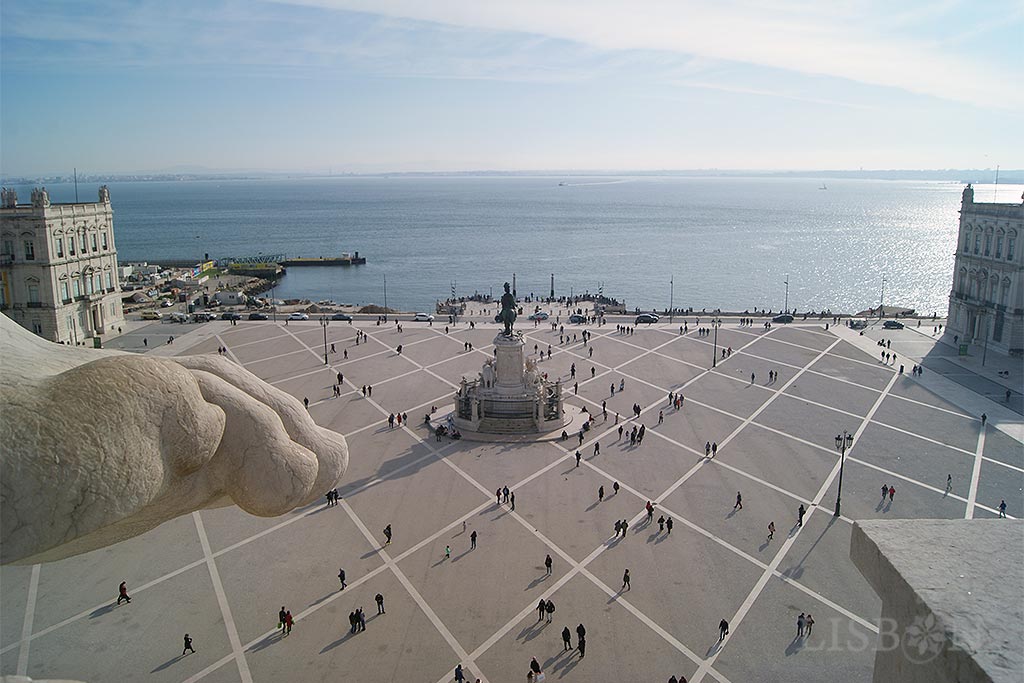
After the devastating earthquake of 1755, it was necessary to rebuild the entire downtown area of the city. For that a team of engineers and architects was formed and was led by minister Marquis of Pombal that under the rules of the Reformist Enlightenment movement created a new modern, rational city with a classic and simple style, the Pombaline Style.
The monumental Praça do Comércio was built over the former Terreiro do Paço. The royal palace that used to exist there since the 16th century and that collapsed was solely symbolically replaced by the equestrian statue of King José I.
The square, composed by buildings with arcades, is perfectly symmetric and has two towers both on the east and west sides, while the south side faces the river and the north side faces the new city. The Triumphal Arch of Praça do Comércio, the noble entrance of Lisbon, was projected for the north end since the beginning.
The Triumphal Arch of Praça do Comércio – A Slow Process
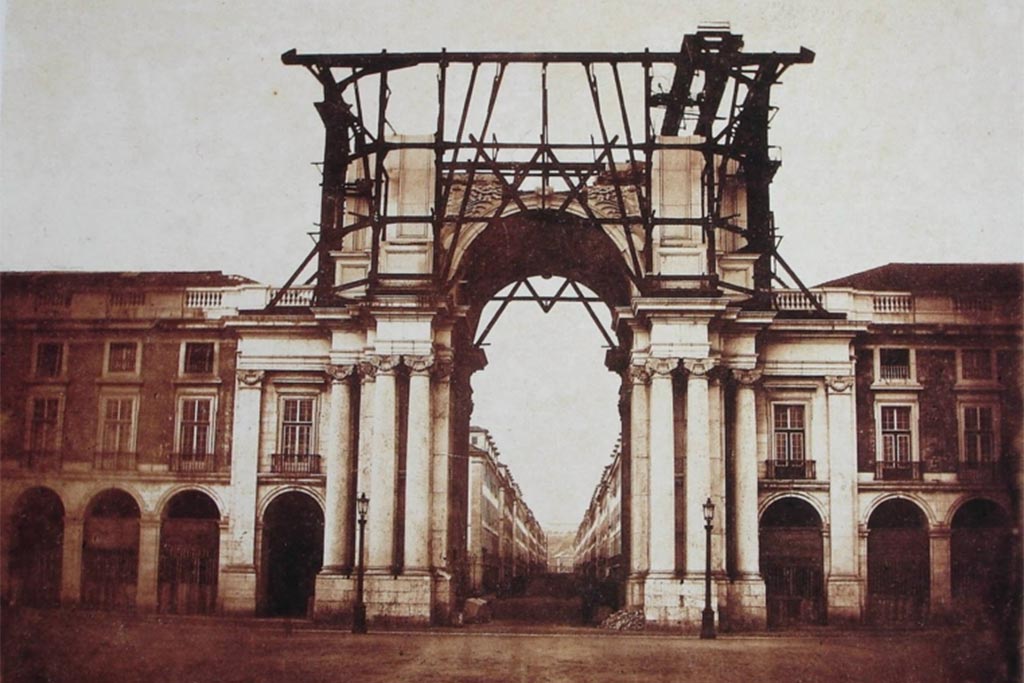
The first project, by Eugénio dos Santos, was classic and simple and was approved in 1758. It was a round arch sided by statues in niches, with a triangular pediment and topped by a sculpture set.
In 1762 the architect passed away and was substituted by Carlos Mardel who presented a new proposal. More connected to a baroque model, this proposal replaces the pediment with a tall bell tower and a clock, decorated with pinnacles and flame-shaped sculptural ornaments.
Just like the previous one, this project long awaited its execution, seeing that the economic resources of the kingdom were being destined to more important works.
With time passing by, the political context as well as people’s tastes changed and new ideas arose, which triggered a heated discussion among the people of Lisbon.
Thus, the execution of the Triumphal Arch of Praça do Comércio was successively delayed. First due to the withdrawal of Marquis of Pombal from the government in 1777 and later due to the political and economical instability that resulted from the civil war in the early 1800s.
However, in 1815 the support columns were built and only in 1873 was finally inaugurated the monument projected by Veríssimo José da Costa, a solution that merges the best of the two previous proposals.
From Eugénios dos Santos he chose to include the sculpture sets, as well as the classic lines and balanced proportions; from Carlos Mardel he included the clock and placed it facing north, while the south side features the coat of arms of Portugal. Plus, he added a baroque style with the rococo decoration that surrounds them.
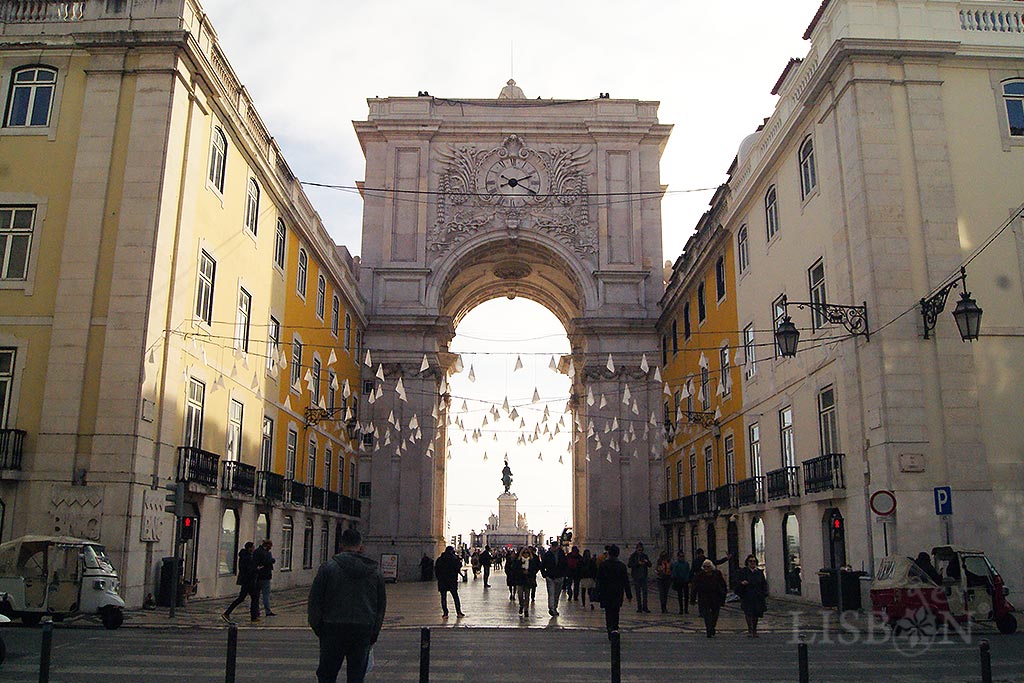
Veríssimo José da Costa kept the already built base but discarded the triangular pediment from the two previous projects, replacing it with a rectangular structure that corresponds to a wide hall, where we can see the clock mechanism, as well as a superb view from both the large lateral windows.


The Sculptures of the Triumphal Arch of Praça do Comércio
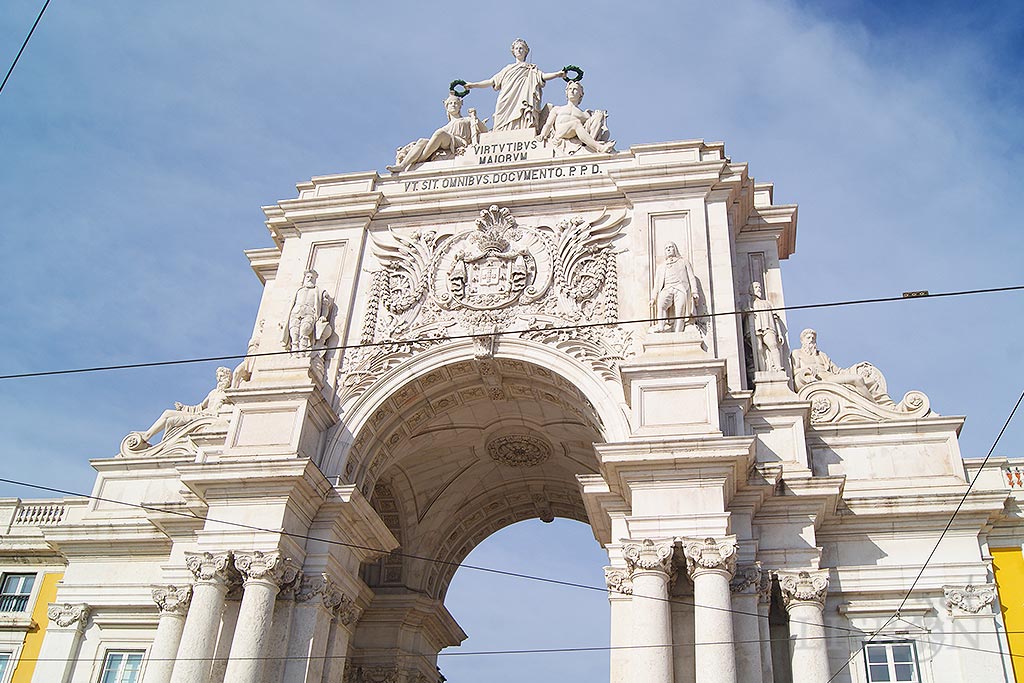
The sculptures present in the Triumphal Arch of Praça do Comércio resulted from an iconographic programme from the French artist Célestin Anatole Calmels (1822-1906). This artist executed, among others, the emblematic works of the Allegories on the sides of the portal of Palmela Palace and the sculpture set of the pediment of the City Council of Lisbon.
On the south side of the arch, the artwork on the top level was executed by the Portuguese romantic sculptor Victor Bastos (1830-1894), author of, among other pieces, the monument of tribute to the poet Luís de Camões, situated in the Square named after him.
The Statues on the Top Level
They are the colossal allegories of the rivers Tagus (west side) and Douro (east side) on the sides of the building; and two pairs of statues that represent four important figures of the History of Portugal.
While the representations of these same rivers in the statues of Liberdade Avenue are harder to distinguish, here they’re more clearly identified. The statue on the east side features a bunch of grapes, which we immediately associate to the Demarcated Region of Douro, instituted in 1756 during the governance of Pombal. On the opposite side the Tagus seems to have had an object on its hand, but whatever it was is now broken.
When it comes to the statues, from left to right we can find: on the west side, Viriathus (181 BC-139 BC), the mythical leader of Lusitanian people, followed by Vasco da Gama (1469-1524), the navigator and explorer that discovered the sea route from Europe to the East.
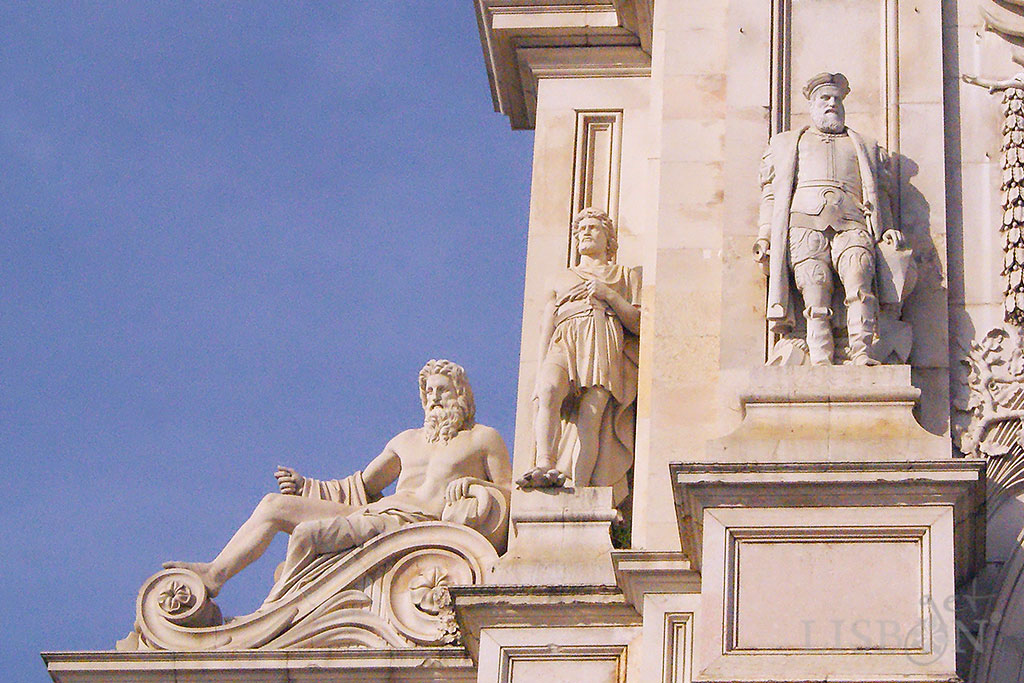
On the east side, from left to right we can see Marquis of Pombal (1699-1782), who was responsible for the development of the country and for the reconstruction of the capital. A figure that certainly wouldn’t have had a place here if the arch hadn’t been built so belatedly. Finally we see Constable Nuno Álvares Pereira (1360-1431), an equally important personality of the History of Portugal and Lisbon and founder of the Carmo Convent.
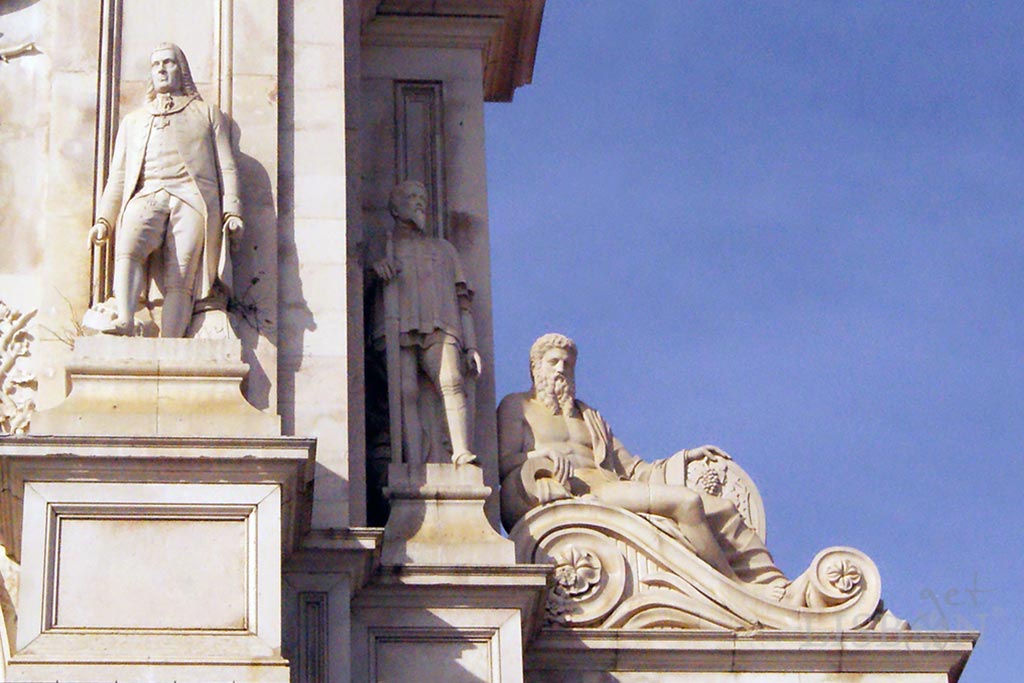
Four personalities from different times and of distinct qualities but all certainly related to the allegories on the top of the arch: Valour and Genius crowned by Glory.
| Never miss another article | Subscribe here |
The Sculpture Set that Tops the Arch
This last stone sculpture set presents us three figures: the middle one is standing and represents Glory, who is holding two bronze bay crowns on top of the head of two seated figures next to her.
Below them we can see the inscription: “VIRTVTIBVS MAIORUM VT SIT OMNIBVS DOCMENTO. P.(ECVNIA) P.(VBLICA) D.(ATVM)”, which means: By virtue of the Greatest, so that it may serve everyone as a teaching. Dedicated to public expenditure. ”

On the west side we can see the female figure of the goddess Minerva wearing a plume helmet and holding a sword, with a lion resting by her side. On the two sides of the helmet are presented two small winged dragons, which remind us of the symbol of the House of Aviz.
The roman goddess Minerva, associated with the greek Athena, is the goddess of wisdom, strategic warfare and the sponsor of arts, hence being connected to Valour.
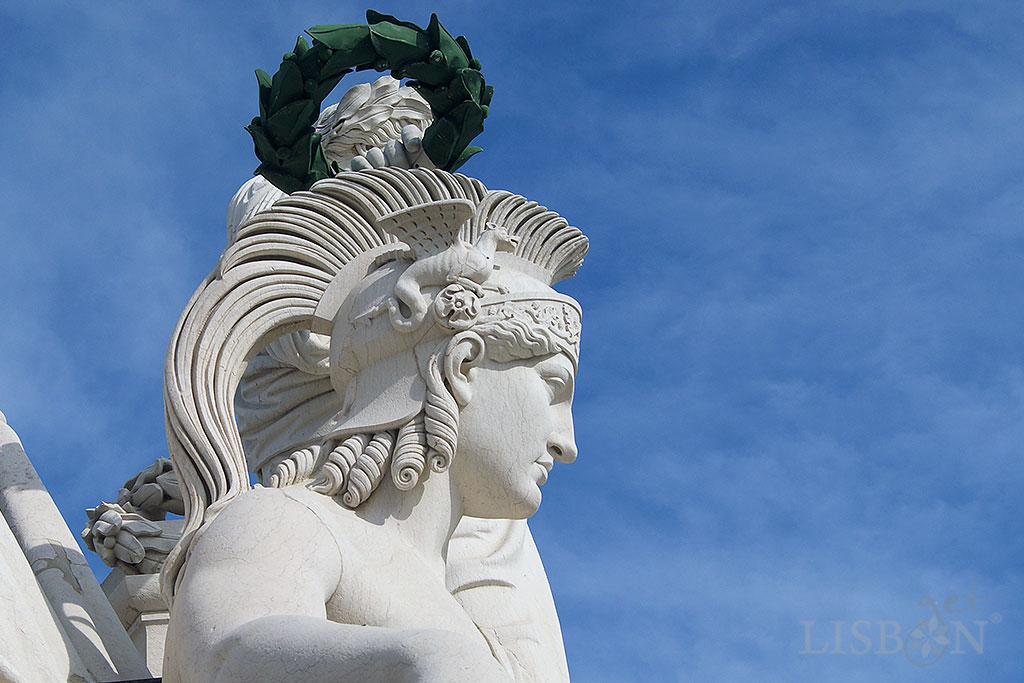
Genius is here represented on the east side by the god Apollo with books and a lyre. In this case the beardless young figure has wings, which connects it to the Christian figure of the Archangel Michael.
On top of one of its wings there’s a discreet small figure of a philosopher that we hypothetically associate to the roman writer of the 1st century BC Virgil.

The symbology of the Triumphal Arch of Praça do Comércio, the Equestrian Statue of King José I, the Cais das Colunas and even the dimensions and proportion of the Square and of the buildings that constitute it, have been targets of interpretations that tend to emphasise its masonic and esoteric character. We leave these reflections to the specialists.
To finish off, we must suggest you visit the Triumphal Arch of Praça do Comércio that has been open to the public since 2013. You can access it in Rua Augusta by going on an elevator and then going up a few stairs. You’ll have access to a terrace where you can admire the stunning view.
The project getLISBON has been very rewarding and we want to continue revealing the singularities of fascinating Lisbon.
Help us keep this project alive!
By using these links to make your reservations you’ll be supporting us. With no extra costs!
• Looking for a different experience? We can create a customised itinerary based on your interests. Contact us!
• Or if you prefer tours and other activities in various destinations, take a look at GetYourGuide.
• Save time and money with a flexible Lisbon Card!

